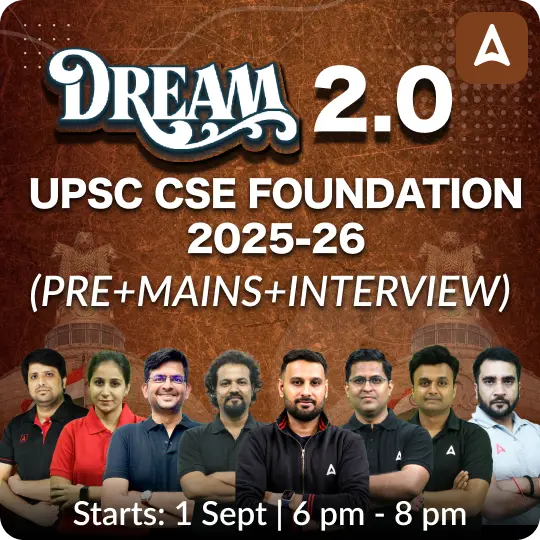Table of Contents
The doctrine of Checks and balances in India distributes power between government branches (legislature, executive, judiciary) and lets them limit each other’s actions. This prevents any one branch from becoming too powerful. This article covers the Doctrine of Checks and Balances, an important topic included in the UPSC Indian Polity and Governance Syllabus.
Doctrine of Checks and Balances
The doctrine of checks and balances is a fundamental principle in government structures designed to prevent any branch from wielding absolute power. It functions by dividing the government into separate branches, typically the legislature, executive, and judiciary, each with its specific powers. These branches are then given tools to limit the actions of the others.
This can include the legislature passing laws, the executive enforcing those laws and carrying out government functions, and the judiciary interpreting the laws and striking down any that are considered unconstitutional. This system fosters cooperation and prevents any one branch from becoming too powerful.
Constitutional Provisions of Checks and Balances
The Constitution of India doesn’t follow a strict separation of powers but emphasizes ‘checks and balances’.
| Article | Description |
| Article 13(2) |
The Judiciary can review legislative laws made by Parliament.
|
| Articles 32 and 226 |
Supreme Court and High Courts issue writs to hold the executive and legislature accountable.
|
| Article 61 | The president can be impeached. |
| Articles 75 and 164 |
Council of Ministers responsible to Lok Sabha and State Legislative Assembly respectively.
|
| Article 81 | Disqualification of Members of Parliament. |
| Articles 124 and 218 |
Procedure for impeachment of judges of Supreme Court and High Court.
|
| Article 148 |
The Comptroller and Auditor General of India, appointed by the President, audits finances made by the executive to Parliament
|
Doctrine Checks and Balances on Different Organs
The Indian Constitution ensures a system of checks and balances to prevent any one branch of government from overpowering another.
On the Executive
- In parliamentary proceedings, various instruments like no-confidence motions, question hours, and censor motions hold the government accountable to the parliament.
- The Constitution allows for Judicial Review, enabling courts to review laws passed by Parliament to ensure they comply with the Constitution’s basic features.
- Any law contradicting these features can be declared void by the court.
On the Legislature
- The Constitution prevents legislators from interfering with the executive’s role to avoid conflicts of interest between these essential branches of government.
- The judiciary can use Judicial Review to assess legislation and declare it void if it violates constitutional principles.
- Legislators are also prohibited from discussing the conduct of judges from High Courts and the Supreme Court in Parliament.
On the Judiciary
- The Constitution provides for the impeachment of judges found guilty of misconduct or failing to uphold their responsibilities.
- Judicial appointments, including judges, require approval from the government after being endorsed by the collegium.
| Branch | Power |
Checks on Other Branches
|
| Legislature | Creates laws, controls budget, approves treaties |
Overrides vetoes with supermajority, impeaches and removes officials
|
| Executive | Executes laws, commands military conducts foreign policy |
Vetoes legislation (can be overridden), appoints officials subject to legislative approval
|
| Judiciary | Interprets laws, reviews the constitutionality of laws and actions |
Declares laws or actions unconstitutional (can be appealed or new laws passed)
|
Challenges to the Doctrine of Checks and Balances
Challenges to the Doctrine of Checks and Balances may arise due to various concerns and issues:
- Judicial Overreach: The judiciary might exceed its authority by meddling in the affairs of the legislature and the executive. As the sole interpreter of laws passed by Parliament, it can sometimes extend its jurisdiction beyond its intended limits.
- Parliamentary Committees: While the constitution allows for the formation of parliamentary committees to alleviate the executive’s workload, their recommendations are merely advisory. Neither the parliament nor the executives are obligated to follow these suggestions.
- Parliamentary Proceedings: Repeated use of parliamentary tools like no-confidence motions and question hours can disrupt the smooth functioning of parliament, affecting its efficiency and effectiveness.
Check UPSC Indian Polity Notes
Conclusion of Checks and Balances
The Constitution has established numerous measures to maintain checks and balances among the executive, judiciary, and legislature. This ensures that each branch adheres to the principles outlined in the constitution. While these checks and balances have generally worked effectively, they are not without flaws.
However, the Constitution allows for some flexibility to accommodate India’s unique needs. Yet, it’s crucial to prevent any misuse of this flexibility to strengthen the checks and balances system and uphold the democratic spirit of our nation.



 TSPSC Group 1 Question Paper 2024, Downl...
TSPSC Group 1 Question Paper 2024, Downl...
 TSPSC Group 1 Answer key 2024 Out, Downl...
TSPSC Group 1 Answer key 2024 Out, Downl...
 UPSC Prelims 2024 Question Paper, Downlo...
UPSC Prelims 2024 Question Paper, Downlo...







